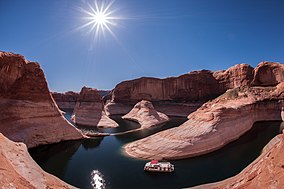Recreational Use Impacts: Difference between revisions
No edit summary |
No edit summary |
||
| Line 22: | Line 22: | ||
==Best Practices Resources== | ==Best Practices Resources== | ||
{{Document Icon}} [[Hydrologic Engineering Requirements for Reservoirs (EM 1110-2-1420) | Hydrologic Engineering Requirements for Reservoirs (EM 1110-2-1420), USACE | {{Document Icon}} [[Hydrologic Engineering Requirements for Reservoirs (EM 1110-2-1420) | Hydrologic Engineering Requirements for Reservoirs (EM 1110-2-1420), USACE]] | ||
<!-- For information on notation for in text citations visit https://www.mediawiki.org/wiki/Help:Cite Or simply enclose the citation as shown <ref> citation </ref> in the location of the in text mention. Citations will automatically populate below--> | <!-- For information on notation for in text citations visit https://www.mediawiki.org/wiki/Help:Cite Or simply enclose the citation as shown <ref> citation </ref> in the location of the in text mention. Citations will automatically populate below--> | ||
Revision as of 22:39, 11 July 2023

|
| The Glen Canyon National Recreation Area, which includes Lake Powell and vicinity, is an example of a reservoir which was transformed into a popular recreational area for locals and tourists alike. (Wikipedia) |
“Recreational use of the reservoirs may extend throughout the entire year. Under most circumstances, the optimum recreational use of reservoirs would require that the reservoir levels be at or near full conservation pool during the recreational season”. [1]
“In addition to the seasonal regulation of reservoir levels for recreation, regulation of project outflows may encompass requirements for specific regulation criteria to enhance the use of the rivers downstream from the projects, as well as to ensure the safety of the general public… During the park recreation season, streamflows are regulated to ensure the safety of the public who may be engaged in water related activities, including boating, swimming, fishing, rafting, and river drifting. Also, the aesthetics of the rivers may be enhanced by augmenting streamflows during the low-water period. Water requirements for maintaining or enhancing the recreational use of rivers are usually much smaller than other major project functional uses… Of special importance is minimizing any danger that might result from changing conditions of outflows which would cause unexpected rise or fall in river levels”. [1]
See also: Public Safety
Best Practices Resources
![]() Hydrologic Engineering Requirements for Reservoirs (EM 1110-2-1420), USACE
Hydrologic Engineering Requirements for Reservoirs (EM 1110-2-1420), USACE
Citations:
Revision ID: 7201
Revision Date: 07/11/2023
